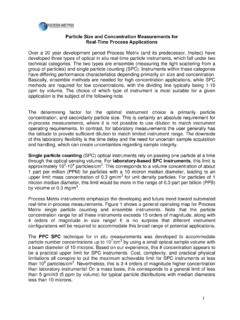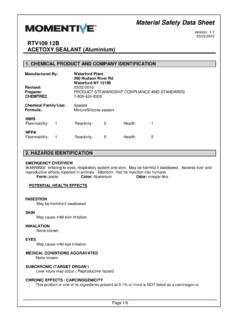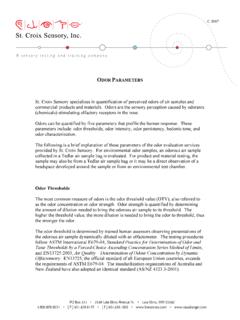Transcription of DIETHYL HYDROXYLAMINE AS OXYGEN …
1 DIETHYL HYDROXYLAMINE AS OXYGEN scavanger FOR BOILER WATER TREATMENT ANIL KHERA, N. ANBANANTHAN Ion Exchange India Ltd 19/A, Phase II, Industrial Development Area, Patancheru 502 319, Medak Dist, AP, India. Waterside corrosion is a major problem in steam generation systems causing damage, inconvenience, down time, replacements and cosequent financial losses every year. The corrosion can take place in pre-boiler, feed water systems, boiler drums & tubes and post boiler system comprising of steam and condensate equipments piping. The cause for corrosion is primarily due to the presence of dissolved OXYGEN and carbondioxide. The presence of dissolved OXYGEN is found as key cause of feed water, boiler water and even condensate corrosion in boiler system whereas carbon dioxide is known to cause corrosion in return line condensate system.
2 OXYGEN corrosion occurs through an electrolytic process using the boiler system metal as current path and boiler water as an electrolyte. To control the corrosion due to OXYGEN , the feed water should be free of OXYGEN . Various methodologies were adopted to remove the dissolved OXYGEN . The dissolved OXYGEN in the feed water is partially removed by thermal deaeration. The removal of dissolved OXYGEN is not complete in this process and the residual dissolved OXYGEN is normally about ppm. This low concentration can influence the corrosion. The residual dissolved in water OXYGEN can be removed by using OXYGEN scavengers.
3 Corrosion by OXYGEN in the boiler can be controlled by the addition of an OXYGEN scavenger to the preboiler section of the steam generating system. One of the oldest OXYGEN scavenger is sodium sulphite. In 1920, sodium sulphite was first used as an OXYGEN scavenger. Later, hydrazine was first introduced in Germany in early forties. Due to the introduction of high pressure boilers, the demand for the use of hydrazine increased compared to sodium sulphite. Hydrazine is technically superior when compared to sodium sulphite especially in high pressure boilers. In addition to its OXYGEN scavenging capabilities, hydrazine could able to passivate ferrous metallurgy present in the boiler.
4 In early seventies, hydrazine was identified as a toxic substance and suspected carcnogen. With hightened sensitivity toward employee s health and safety, the water treatment industry directed their efforts towards the development of alternative OXYGEN scavanger . Many alternative OXYGEN scavangers were developed. These include catalysed diethylhydroxylamine (DEHA), carbohydrazide, methyl ethyl ketoxime (MEKO), hydroquinone, erythorbic acid etc. The catalysed OXYGEN scavenger DIETHYLHYROXYLEAMINE (DEHA) was first introduced in India by Ion Exchange India. Properties of DEHA DEHA is a colourless to pale yellow transparent liquid.
5 It is the derivative of hydroxyl amine. It is freely soluble in water. Chemically it is a reducing agent and hence it oxidizes. It reduces ferric ion and converts into ferrous ion. Thermally in presence of water, it decomposes . The details of the above chemical properties with reference to high temperature systems are discussed here. Oxidation of DEHA DEHA reacts with dissolved OXYGEN leaving to harmless byproducts. The overall reaction of DEHA with dissolved OXYGEN can be summarized as here below: 4 (CH3CH2) 2 NOH + 9O2 CH3 COOH + 2N2 + 6 H2O According to above equation g of DEHA is required to remove 1 g of dissolved OXYGEN . However, in practice, it has been observed that about 4-ppm of DEHA is required.
6 It is, therefore, probable that the reaction does not follow the above direct path but involves various intermediate steps. Various mechanisms are available for such high consumption of DEHA in the literature. Acetic acid is one of the major decomposition of DEHA. The acetic acid formed due to the decomposition of DEHA is retained by hydroxide alkalinity in boiler and is not found in steam. It gets converts into acetate salt and under most boiler conditions presence of it does not create any problems. However, in systems operated without hydroxide alkalinity, small portions of acetic acid at ppb level were observed.
7 Such situations apply to high-pressure boilers where all volatile treatments are used. As the level of dissolved OXYGEN after deaerator is so small, the acetic acid level will also be correspondingly very low indeed. However, the presence of acetic acid does not mean that it is only originated from DEHA. Instances were reported especially in nuclear power plants that the acetic acid could also be formed due to the presence of organics in the feed water. Apart from acetic acid nitrites, nitrates and acetaldehyde are also reported to be formed due to DEHA oxidation. Table 1 summarizes the various byproducts formed due to DEHA oxidation and their implications.
8 Table 1 depicts the details of nitrites, nitrates and acetaldehyde. OXIDATION PRODUCTS Details Nitrites and nitrates Fund only in boiler. Nitrite is found below 1000 psig and concentration of nitrite found is very low. Levels are insignificant for boiler operation. Acetaldehyde Is found almost entirely in steam due to low boiling point (21 deg c at atmospheric pressure). Its toxicity is low and do not pose any major problem in boiler operation. Reduction of ferric ion As iron is exposed to an aqueous environment, it begins to corrode leading to formation of rust Fe2O3 (Hematite). The iron in haematite is found in Fe3+ form. DEHA reduces Fe3+ to Fe2+. The partial reduction of Fe3+ to Fe2+ leads to the formation of magnetite, Fe3O4.
9 The magnetite layer act as a passive layer and thus provides a protective barrier against the corrosive attack. Thermal decomposition of DEHA DEHA is thermally stable up 300 psig and some breakdown occurs at 1000 psig. The major thermal decomposition products appear to be diethylamine or ethylmethylamine. It further decomposes to ammonia. But the quantities of ammonia formation are insignificant under most operating conditions. It is to be noted that the decomposition of DEHA initiates from 540 F only. The byproducts of DEHA, amines are helpful in raising pH of condensates. This reduces the consumption of neutralizing amines.
10 The formation of ammonia is very low and hence threat to yellow metallurgy in the system is very minimum when compared to hydrazine based treatment. Advantages of DEHA over sulfite and hydrazine Reaction kinetics The reaction rate of reaction with dissolved OXYGEN depends upon pH, temperature and concentration of both DEHA and dissolved OXYGEN itself. Figure 1 depicts the sulfite reacts faster than hydrazine and DEHA at 21 C and pH whereas DEHA reacts faster than Hydrazine. DEHA takes the second position in the spectrum. However, considering the high pressure operation, DEHA takes the first position. Moreover, when DEHA is catalyzed, the activity could be enhanced.








